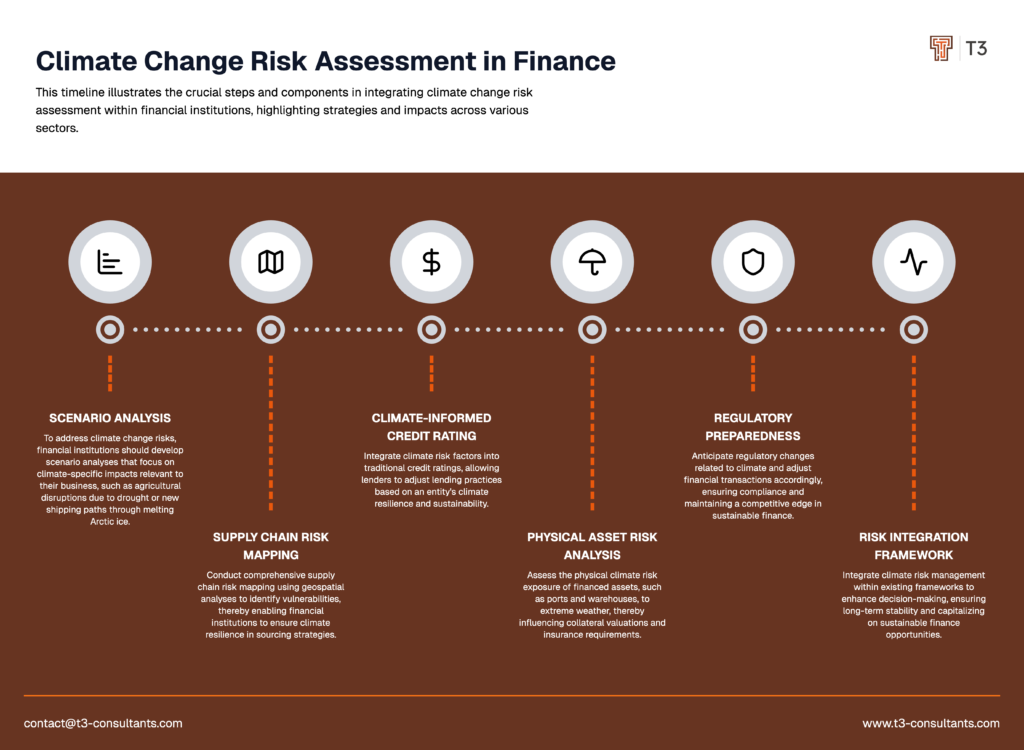ESG Solutions
Climate ChangeChange Risk Assessment
Climate Change Risk Assessment is identifying, analysing, and controlling the potential financial impacts of climate change on a financial institution. These impacts are largely divided into two categories:
- Physical risks: Immediate or eventual financial losses due to disruptions in weather patterns, sea levels rising, scarcity of resources, water and food disruptions.
- Transition risks: Immediate or eventual financial losses due to technological changes, regulatory changes, changes in social values resulting in the value of certain finsncial assets diminishing.
Sophisticated Climate Risk Assessment for Financial Institutions
Financial institutions involved in trade finance face a growing need to consider climate risks when assessing transactions. Here are ways to enhance their risk management approaches:
1-Climate-Focused Scenario Analysis:
- Trade-Specific Scenarios: Develop climate scenarios specifically relevant to traded goods and supply chains. For example, drought scenarios impacting agricultural commodities or changing shipping routes due to melting Arctic ice.
- Exposure Mapping: Integrate scenario results into workflow tools to visualize geographic hotspots where assets, suppliers, or logistics routes face heightened climate risk.
2- Supply Chain Risk Mapping:
- Upstream and Downstream Impacts: Employ geospatial analysis and supplier risk assessments to map the climate vulnerability of entire supply chains, beyond the immediate exporter/importer.
- Alternative Sourcing:
Workflow tools can flag high-risk supply chains and integrate climate resilience scores of alternative sources, enabling adaptation decisions.
3- Climate-Informed Credit Ratings:
- Augmented Data: Integrate climate risk factors and scenario analysis into traditional credit scoring models. This allows for a more nuanced assessment of a company’s financial health under potential climate disruptions.
- Green vs. Brown Penalties/Premiums: Workflow tools could automatically calculate adjustments to lending rates or trade finance terms based on a company’s climate resilience and sustainability practices.
- Physical Asset Risk Analysis: Coastal Properties: Assess the exposure of port facilities, warehouses, and other infrastructure financed by trade transactions to sea-level rise, flooding, and extreme weather events.
- Workflow Integration: Workflow systems can incorporate these risk assessments, influencing collateral valuation and insurance requirements.
5-Regulatory Preparedness:
- Anticipating Green Trade Finance Rules: Proactively model how potential regulations around carbon tariffs, climate-related export restrictions, or sustainable financing incentives might impact specific trade flows.
- Scenario Planning: Update workflow decision points to incorporate potential impacts of climate regulations on deals.
Why have an Integrated Climate Risk Assessment
- Improved Risk Management and Portfolio Resilience: By proactively identifying climate-related risks across lending, investment, and insurance portfolios, financial firms can make better-informed decisions. This reduces exposure to losses arising from climate-driven events and economic disruptions.
- Enhanced Investment Opportunities: Sophisticated analysis can uncover potential investments in sustainable businesses, green technologies, or climate adaptation projects. Firms can capitalize on the growing investor demand for sustainable finance solutions.
- Client Acquisition and Retention: Demonstrating a commitment to sustainability and climate risk management attracts and retains clients who prioritize responsible investing and risk mitigation. This offers a competitive advantage in an increasingly climate-conscious market.
- Regulatory Compliance and Reputation: Proactive climate risk assessment aligns with emerging regulatory expectations around climate disclosure and stress testing. It strengthens the institution’s reputation and reduces the risk of fines or reputational damage.
- Long-Term Financial Performance: By making informed decisions today that account for climate risks, financial institutions protect their future financial stability and profitability. This creates value for investors and stakeholders.
- Positive Societal Impact: Financial services firms play a crucial role in driving the transition to a low-carbon economy. By strategically allocating capital and managing their own risks, they can contribute to climate change mitigation and a more sustainable future.
Specific Benefits for Different Financial Services Sectors
- Banks: Reduced loan defaults due to climate impacts, better pricing of climate-exposed assets, potential new lending opportunities in green finance.
- Asset Managers: Design of climate-resilient investment portfolios, attracting clients seeking sustainable investment options, potential outperformance by anticipating transition risks.

WHO DOES IT IMPACT?
We help all firms in definiting their ESG solutions (Financial Services, Corporates)
Asset Managers
Banks
Commodity Houses
Fintechs
How Can We Help?
Enhance your business’s environmental strategy with T3’s bespoke services:
1
Climate Change Risk Scoping & Gap Analysis
- Assess your current level of climate risk integration into decision-making processes.
- Identify gaps in data, governance, and risk management practices.
- Prioritize key areas for improvement based on your risk profile and regulatory landscape.
- Help you identify and collect relevant climate risk data (e.g., physical risk data for assets, supplier sustainability metrics).
- Develop cost-effective data management solutions and reporting tools to track climate risks and progress towards mitigation goals.
2
Scenario Analysis for Financial Impact
- Develop customized climate scenarios considering physical risks (e.g., floods) and transition risks (e.g., carbon pricing).
- Analyze the potential financial impact of these scenarios on your loan portfolios, investments, and insurance liabilities.
- Translate findings into actionable insights for portfolio management and risk mitigation strategies.
3
Climate Risk Integration into Existing Frameworks:
- Integrate climate risk considerations into your existing risk management frameworks, including credit risk models, stress testing methodologies, and underwriting guidelines.
- Develop clear and practical tools and processes for ongoing climate risk assessment.
Want to hire
ESG Expert?
Book a call with our experts
